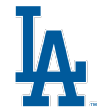The Los Angeles Dodgers are the National League's No. 1 seed in the MLB playoffs after posting baseball's best record during the regular season. The San Diego Padres won more games than any NL team not named the Dodgers to finish second in the West and secure the No. 4 seed.
L.A. made short work of Milwaukee in the wild-card series, and San Diego needed three games to send St. Louis packing. Now, the division rivals meet in a best-of-five with a trip to the NLCS on the line. Here's how both teams got here, keys to the series and more.
Why this NLDS is worth the hype
The Dodgers, who've reached two of the past three World Series without a ring to show for it, are stacked. Mookie Betts, whose No. 50 jersey was MLB's No. 1 seller this season, led an offense that hit more home runs and scored more runs than any team in the bigs. Clayton Kershaw anchored a pitching staff that led the majors in ERA -- and it wasn't even close. That kind of domination in both facets of the game make them the team to beat this October.
The underdog Padres? They'll send to the field the most dynamic player in baseball, the game's next transcendent superstar: 21-year-old shortstop Fernando Tatis Jr. You've probably heard that name before. Tatis can take over a game and do it in style, but he has help, particularly on the left side of the infield in slugging third baseman Manny Machado, who played in the 2018 Fall Classic with the Dodgers.
The Padres' pitching staff is banged up -- more on that in a bit -- but if L.A. is destined to win another pennant, San Diego has the talent to make the Dodgers earn it. This could be a very fun series to watch.
Numbers to know
Series odds: The Dodgers have a 62.9% chance of winning the series. (Odds from ESPN's Bradford Doolittle)
Season series: Los Angeles won 6-4.
Series schedule
Game 1: Tuesday, Oct. 6, FS1 or MLBN
Game 2: Wednesday, Oct. 7, FS1 or MLBN
Game 3: Thursday, Oct. 8, FS1 or MLBN
Game 4: Friday, Oct. 9, FS1 or MLBN (if necessary)
Game 5: Saturday, Oct. 10, FS1 or MLBN (if necessary)
How they got here

Padres: San Diego won the second-most games in the National League (37) to finish six back of the Dodgers in the West. Tatis, Machado and Wil Myers combined for 48 regular-season home runs, then hit five more combined in a series-shifting Game 2 comeback against St. Louis en route to this NLDS.
Wild Card Series: The Padres beat the St. Louis Cardinals 2-1.

Dodgers: Once L.A. acquired Betts from the Boston Red Sox in February, the Dodgers became the odds-on World Series favorite. They did not disappoint, racing to a 43-17 record and posting a plus-136 run differential, both by far the best in baseball.
Wild Card Series: The Dodgers swept the Milwaukee Brewers 2-0.
Keys to the series for the Padres
1. The health of Mike Clevinger and Dinelson Lamet
Beating the Cardinals in three games without your two best starting pitchers is one thing, but beating the Dodgers in five games without them is an enormously more difficult task. Clevinger, whom the Padres paid a hefty price for to acquire him from Cleveland at the trade deadline, is the least likely to be added to the division series roster, based on reports earlier this week when he did not respond well to a bullpen session Tuesday. Clevinger tossed a seven-inning shutout against the Giants on Sept. 13 but has pitched only one inning since then, against the Angels on Sept. 23, leaving that game because of an elbow strain.
Lamet left his final regular-season start on Sept. 25 in the fourth inning because of discomfort in his biceps. He also threw earlier this week. Lamet, who missed the 2018 season after undergoing Tommy John surgery, had a breakout 60-game season, with a 2.09 ERA over 12 starts and finishing with the fourth-highest strikeout rate among starting pitchers and the second-lowest batting average allowed.
Without those two, the rotation is a mess. Chris Paddack has had trouble all season with home runs, and the Cardinals hammered him in Game 1. Zach Davies struggled in his start as well, lasting only two innings, but after going 7-4 with a 2.73 ERA in the regular season probably draws the Game 1 start against the Dodgers. Garrett Richards made 10 starts and finished with a 4.03 ERA but moved to the bullpen late in the season. Other options include Adrian Morejon and perhaps top prospect MacKenzie Gore, who didn't pitch in the regular season but is eligible to be added to the roster. Certainly, Jayce Tingler will have to rely on a lot of innings from his bullpen, but it would be extremely difficult to do two or three bullpen games in a row in five games. At some point, he'll need some effective bulk innings from somebody.
2. Fernando Tatis Jr. must have a big series
OK, maybe it's not a "must" since the Padres lineup is deep and powerful enough to get contributions throughout, but after hitting .313 with 11 home runs in August, Tatis dropped off to .208 and four home runs in September. The Padres averaged 5.48 runs per game in August and 4.95 in September. Tatis then kept the Padres alive with his big two-homer game -- and memorable bat flip -- against the Cardinals. Beyond the numbers though is the feeling that if anybody can carry a team to an upset, it's the dynamic 21-year-old -- not just at the plate, but in the field and with his speed on the bases.
Tatis hit just .205/.244/.385 with two home runs in 10 games against the Dodgers, but he's not the only hitter who fared worse against the Dodgers. The Padres averaged just 3.6 runs against L.A. and hit .224/.288/.410 compared to a season line of .257/.333/.466.
3. How the Padres deploy their relievers
Given that the San Diego starters -- even Lamet, if he's added to the roster -- are unlikely to go deep into the game, that adds a lot of pressure on the middle relievers and that could mean using Matt Strahm and Drew Pomeranz against the Corey Seager/Max Muncy/Cody Bellinger part of the lineup (they hit 2-4-6 against the Brewers). Morejon is another lefty option, although while he struck out 25 in 19⅓ innings he also served up seven home runs. Worth noting is that Strahm is pitching through a knee injury that was clearly causing him some pain when he landed on his front foot. Bellinger in particular was much better against right-handers this year (.854 OPS vs. .666) and Muncy was actually a reverse platoon. It all adds up to some tough decisions for Tingler given the three-batter minimum for relievers (unless the inning ends). Emilio Pagan is another key setup guy, but he has been much better against righties in his career (and a little better this year), so you might want him facing Betts but not Seager. Good luck. There's a reason the Dodgers led the majors in runs. -- David Schoenfield
Keys to the series for the Dodgers
1. Figure it out with Kenley Jansen
Dodgers manager Dave Roberts sounded concerned after Jansen's save in Game 1 of the wild-card series when he said his stuff didn't have "the teeth" he was looking for. Roberts changed his tune the following day. He said Jansen's outing looked a lot better when he went back and watched video and he dismissed any thought that Jansen might no longer be his closer -- even after using Brusdar Graterol to finish a three-run save in Game 2. It was a couple of 86-mph cutters that triggered initial concerns for Roberts and prompted him to get Graterol loose just in case. The following afternoon, Jansen was in the bullpen working to get his delivery properly synced up.
The 33-year-old right-hander had a 3.33 ERA, a 1.15 WHIP and a 3.67 strikeout-to-walk ratio during the regular season, but his numbers would have looked a lot better if not for a couple of bad outings near the middle of September. He was better at incorporating his other pitches, but his velocity was down in his last handful of outings. The Dodgers possess a deep bullpen this year, but their options in save situations outside of Jansen are not as obvious as one might think. The two best alternates, Graterol and Blake Treinen, haven't missed bats at a particularly high rate this year, which is not ideal for tight ninth innings.
2. Get Max Muncy and/or Cody Bellinger on track
With Betts and Seager at the top, and the likes of Will Smith, Chris Taylor and A.J. Pollock exceeding expectations, the Dodgers have had plenty of offense this season. Eventually, though, Muncy and Bellinger have to get right. Their two potent left-handed hitters batted a combined .216 during the regular season and went 2-for-12 with two walks and six strikeouts in two games against the Brewers.
Bellinger tweaked his mechanics during the shutdown and had a hard time finding a consistent rhythm throughout the summer, a process made more difficult without the ability to use video during the game. The reigning NL MVP has particularly struggled with breaking balls and pitches on the inner half of the plate, the type he crushed last season. Muncy began the year with a fractured finger and struggled to establish any consistency with his mechanics, which led to a precipitous drop in his line-drive percentage and a team-high 60 strikeouts.
3. Tame Walker Buehler's blister
Buehler logged one official appearance over the last 19 days of the regular season, a four-inning outing six days before Game 1 of the wild-card series. Against the Brewers, he breezed through the first three innings, then gave up a two-run homer in the fourth and didn't pitch beyond that. The Dodgers knew they could deploy Julio Urias in relief and didn't want to overwork Buehler. You could argue that Buehler basically made only one bad pitch, but the Dodgers' approach with him is proof that his blister -- residing on his right index finger -- can flare up at any moment.
Buehler will get at least five days off between starts, which will certainly help. But there are no off days within the division series or the championship series, which makes it more difficult for the Dodgers to use a starter like Urias in relief if Buehler needs to suddenly come out of his start. Buehler recently consulted with Alex Wood on the matter and has done a good job managing the blister, but it beckons, causing the most issues when he wants to throw his cutter. Not having Buehler at full strength would only intensify the pressure on Kershaw. -- Alden Gonzalez
